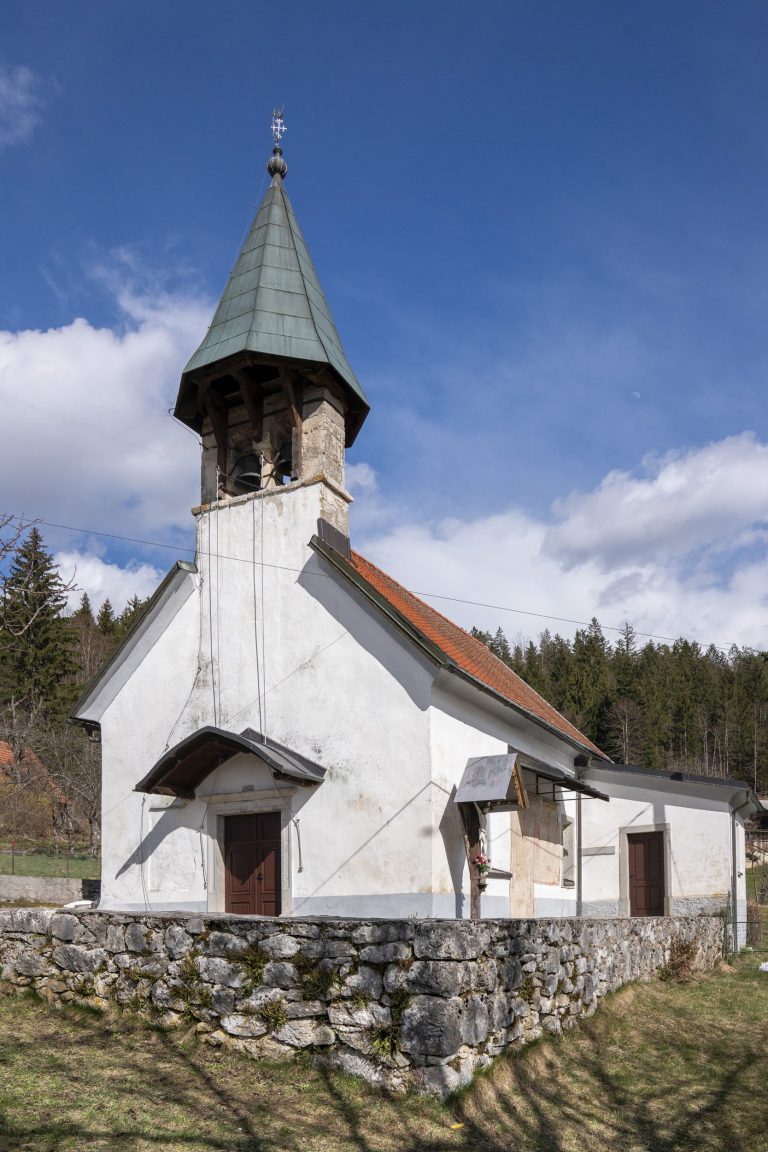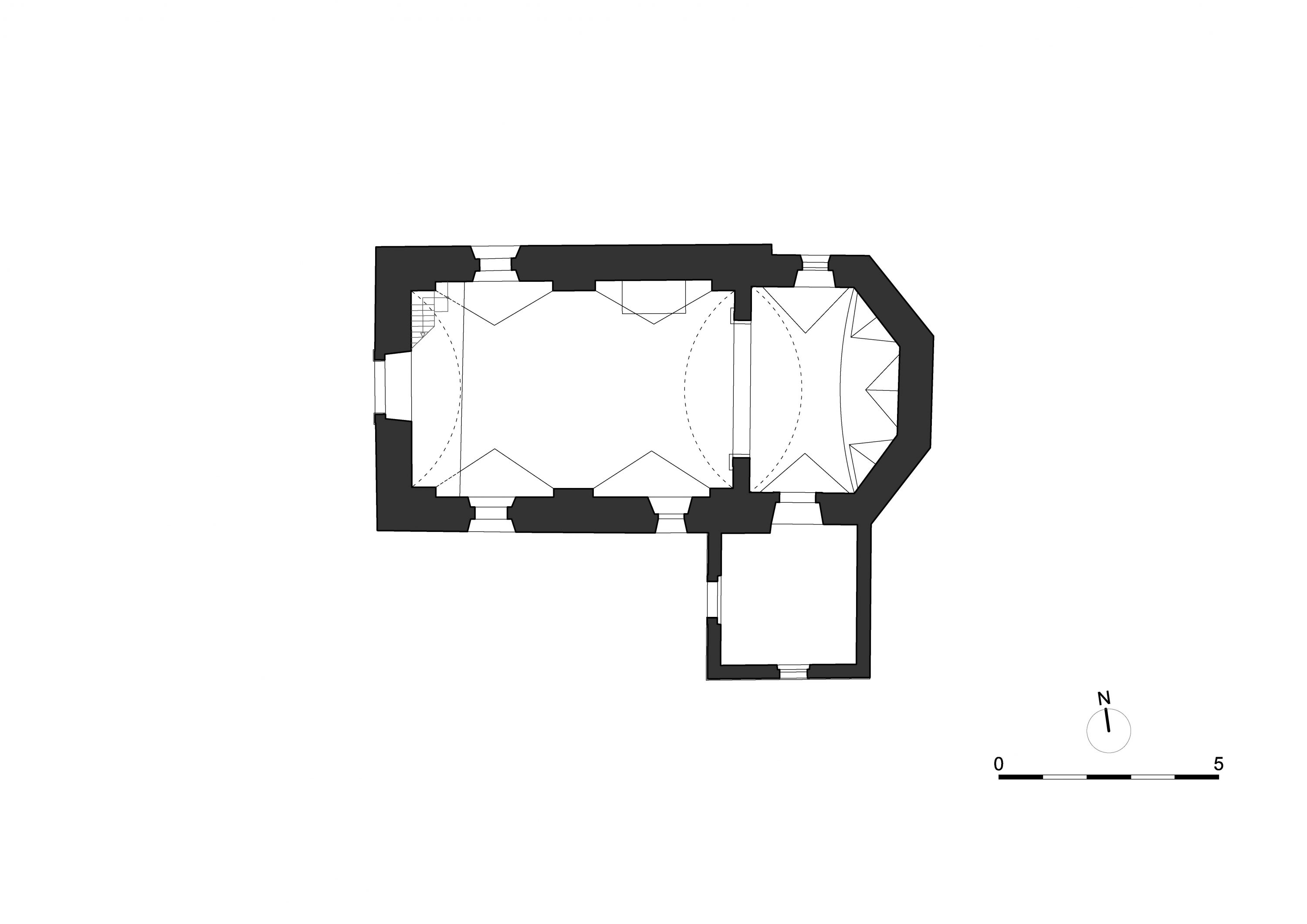List of paintings

The village of Knežja Njiva was first mentioned on 26 June 1384 with its German name Graffenackher,[1] while the church – a branch of the parish of St George in Stari trg pri Ložu – was included in the inventory of Carniolan church treasures in 1526.[2] Its portal bears the year 1665, which refers to its alteration.[3]
________________________________________
[1] KOMATAR 1906, pp. 123–124; Matjaž Bizjak, Miha Preinfalk, Turjaška knjiga listin. Listine zasebnih arhivov kranjske grofovske in knežje linije Turjaških (Auerspergov). 1: 1218–1400, Ljubljana 2008, No. 236; HÖFLER 2017, p. 151.
[2] Cf. HÖFLER 2001, p. 101; HÖFLER 2017, pp. 149, 151.
[3] HÖFLER 2017, p. 151.
In 1676, a new chancel, terminated by three sides of an octagon, was added to the medieval rectangular nave, which was also vaulted at this time.[1] In the 17th century, the church nave was probably heightened and the church altered, as the year 1665 has been preserved on its portal.[2] Remnants of medieval mural paintings, originating from three different periods, have survived both in the interior and the exterior of the building.[3] The church features two side altars from the middle of the 18th century and a high altar from the first quarter of the 18th century,[4] which was restored and gilded by Franjo Vrabec in 1981.[5] The sacristy was added in 1914.[6]
________________________________________
[1] HÖFLER 2001, p. 101. The year is carved in the triumphal arch.
[2] HÖFLER 2017, p. 151.
[3] Nowadays, the Nativity fragment on the church façade is no longer visible. In 1965, France Stele was still able to decipher the inscription Co…a..MALLA de Laas, which was the signature of one of the chaplains of Stari trg, cf. ZRC SAZU, Umetnostnozgodovinski inštitut Franceta Steleta, Ljubljana, Terenski zapiski Franceta Steleta, XXVA, 1965, fols. 19–21; KEBE 1996, pp. 199–200. Janez Höfler dated the Nativity scene to the second half of the 15th century and the partially destroyed fresco of the Man of Sorrows in the interior to around 1520–1530 (HÖFLER 2001, pp. 101–102; cf. KOMELJ 1965, p. 58).
[4] The northern side altar, dating from the middle of the 18th century, bears the inscription S.IsIDorVs HIspanVs agrICoLa pLVVIarVM eXortVS PIVs patronVs (1749). The southern side altar features the chronogram InsIgnIs NotbVrga TyroLensIs In oMnI aVXILIo aDVoLatrIX (1746). Behind the altar, the year 1803 was inscribed when the altar was last restored; Informacijsko-dokumentacijski center za dediščino Ministrstva za kulturo Republike Slovenije, Ljubljana, Zapiski Franceta Steleta, CVI, 1914, 47’.
[5] KEBE 1996, p. 199.
[6] Župnijski arhiv Stari trg pri Ložu, Župnijska kronika, p. 5. Quoted after KEBE 1996, p. 199.
The historical information about the church was collected by Janez Höfler in the book Gradivo za historično topografijo predjožefinskih župnij na Slovenskem. Kranjska.[1] Janez Kebe focused on the church in the context of his research into the history of the parishes of Stari trg pri Ložu and Babno Polje.[2] The murals were analysed by France Stele, Ivan Komelj, Tanja Zimmerman, and Janez Höfler.[3]
HÖFLER 2001
Janez HÖFLER, Srednjeveške freske v Sloveniji. 3: Okolica Ljubljane z Notranjsko, Dolenjsko in Belo Krajino, Ljubljana 2001.
HÖFLER 2017
Janez HÖFLER, Gradivo za historično topografijo predjožefinskih župnij na Slovenskem. Kranjska, Ljubljana 20172, www.viharnik.com/downloads/HistTop_Kranjska2.pdf.
KEBE 1996
Janez KEBE, Loška dolina z Babnim Poljem. Zgodovina župnij Stari trg pri Ložu in Babno Polje, Ljubljana 1996.
KOMATAR 1906
Franc KOMATAR, Das Schloßarchiv in Auersperg, Mittheilungen des Musealvereines für Krain, 19/3–4, 1906, pp. 99–140.
KOMELJ 1965
Ivan KOMELJ, Dvajset let odkrivanja srednjeveških stenskih slik, Varstvo spomenikov, 10, 1965, pp. 39–76.
STELE 1669
France STELE, Slikarstvo v Sloveniji od 12. do 16. stoletja, Ljubljana 1969.
ZIMMERMANN 1996
Tanja ZIMMERMANN, Stensko slikarstvo poznega 13. in 14. stoletja na Slovenskem, Ljubljana 1996 (doctoral thesis typescript).
________________________________________
[1] HÖFLER 2017, p. 151.
[2] Cf. KEBE 1996, pp. 199–200.
[3] KOMELJ 1965, p. 58; STELE 1969, pp. 65, 66; ZIMMERMANN 1996, p. 87; HÖFLER 2001, pp. 101–102.
The written sources known so far – mostly censuses and reports – were published by Janez Höfler.[1] According to the author, the church of the Holy Trinity in Knežja Njiva is mentioned in the following sources:
1526: Inventarium ober die kürchen Cleinodien in ganzen Land Crain – an inventory of valuables taken from Carniolan churches;[2]
1573: an extract from the urbarium of the Lož seigniory dated 10 April 1573, noting the advocacy of certain parish and succursal churches of the parishes of Stari trg pri Ložu, Bloke, and Cerknica;[3]
1581: a list of Carniolan churches of the diocese of Aquileia, drawn up by Paolo Bisanzio, the bishop of Kotor and suffragan of the patriarch of Aquileia;[4]
1689: Johann Weichard VALVASOR, Die Ehre deß Hertzogthums Krain, Laybach 1689;[5]
1713: a list of churches in the parish of Stari trg pri Ložu from the report on the hearing of parishioners and churchwardens in front of the Vicedom’s secretary on 2 July 1713 regarding the economic situation;[6]
1741: a visitation report by the Archdeacon of Ribnica Karl Sigismund Petazzi;[7]
1783: Consignation deren bis 25 August 783 rückständigen Fassionen aller Kirchen und Kapellen in dem Herzogthume Krain.[8]
________________________________________
[1] HÖFLER 2017, p. 151.
[2] Arhiv Republike Slovenije, Ljubljana, AS 2, Deželni stanovi za Kranjsko, 1. reg., box 82, binder 48b, fascicle 3 (the Slovenian summary with a commentary is deficient); Anton KOBLAR, Kranjske cerkvene dragocenosti l. 1526, Izvestja Muzejskega društva za Kranjsko, 5/4, 1895, pp. 143–153. Quoted after HÖFLER 2017, pp. 29, 151.
[3] A transcription of 4 May 1643. Quoted after HÖFLER 2017, pp. 29, 151.
[4] Biblioteca arcivescovile Udine, Videm, No. 737, 13. The source was published in Janez Höfler, Trije popisi cerkva in kapel na Kranjskem in Slovenskem Štajerskem s konca 16. stoletja, Ljubljana 1982. Quoted after HÖFLER 2017, pp. 29, 151.
[5] Unless otherwise stated, the information comes from Volume 2, Book 8. Quoted after HÖFLER 2017, pp. 27, 151.
[6] Arhiv republike Slovenije, Ljubljana, AS 1, Vicedomski urad za Kranjsko, Cerkvene zadeve, seznam cerkva župnije Stari trg pri Ložu iz poročila o zaslišanju faranov in cerkvenih ključarjev glede gospodarskega stanja pred vicedomskim tajnikom dne 2. julija 1713; cf. Majda SMOLE, Vicedomski urad za Kranjsko. 13. stol.–1747. Cerkvene zadeve, 4, Ljubljana 1994, pp. 65–66. Quoted after HÖFLER 2017, pp. 32, 151.
[7] Summarised in Anton SKUBIC, Zgodovina Ribnice in ribniške pokrajine, Buenos Aires 1976, pp. 45–54. Quoted after HÖFLER 2017, pp. 32, 151.
[8] Arhiv Republike Slovenije, Ljubljana, AS 7, Deželno glavarstvo, Ecclesiastica, Ref. No. 222, Lit. F, No. 8. The list is supplemented by an inventory of dioceses, provostries, canonries, and benefices simplex (1783/I), as well as of parishes and sub-parishes (1783/II) and confraternities (1783/III). The places and parishes on the list are arranged in alphabetical order, with the exception of those whose branches are only listed according to their dedications. Quoted after HÖFLER 2017, pp. 33, 151.
In 1963, murals were uncovered on the southern exterior wall of the nave and restored in 1967 by the restorer and academy-trained painter Tomaž Kvas. At the request of the parish priest, he also considerably reconstructed the unpreserved parts of the frescoes. The same occurred in the case of the Nativity scene on the western façade, to the left of the belfry, which has not been preserved to date. Meanwhile, in the interior, the restorer uncovered a more recent image of the Man of Sorrows, half of which had been destroyed.[1] Later, the roof was restored, while a small roof was also constructed on the southern side of the church to preserve the frescoes.[2] The Institute for the Protection of Cultural Heritage of Slovenia, Ljubljana regional unit, does not keep any documentation on the works in the church.
________________________________________
[1] The progress of the works is evident from the correspondence between the Stari trg pri Ložu parish office and the Ljubljana unit of the Institute for the Protection of Cultural Heritage of Slovenia between 1963 and 1967, kept at the Information and Documentation Centre of the Ministry of Culture of the Republic of Slovenia, Ljubljana (folders 59, 101, 194).
[2] Oral source: Janez Kebe.




Legal Terms of Use
© 2025 ZRC SAZU UIFS, Corpus picturarum muralium medii aevi
ZRC SAZU
France Stele Institute of Art History
Novi trg 2
1000 Ljubljana


Spodaj seznam podrobno opisuje piškotke, ki se uporabljajo na našem spletnem mestu.
| Cookie | Type | Duration | Description |
|---|---|---|---|
| _ga | Non-Necessary | 2 years | This cookie is installed by Google Analytics. The cookie is used to calculate visitor, session, camapign data and keep track of site usage for the site's analytics report. The cookies store information anonymously and assigns a randoly generated number to identify unique visitors. |
| _gat | Non-Necessary | 1 minute | Google uses this cookie to distinguish users. |
| _gid | Non-Necessary | 1 day | This cookie is installed by Google Analytics. The cookie is used to store information of how visitors use a website and helps in creating an analytics report of how the wbsite is doing. The data collected including the number visitors, the source where they have come from, and the pages viisted in an anonymous form. |
| cookielawinfo-checkbox-necessary | Necessary | 1 year | This cookie is set by GDPR Cookie Consent plugin. The cookies is used to store the user consent for the cookies in the category "Necessary". |
| cookielawinfo-checkbox-non-necessary | Necessary | 1 year | This cookie is set by GDPR Cookie Consent plugin. The cookies is used to store the user consent for the cookies in the category "Non Necessary". |
| CookieLawInfoConsent | Necessary | 1 year | The cookie is used to store the summary of the consent given for cookie usage. It does not store any personal data. |
| PHPSESSID | session | Time of session | Cookie stores information about the user's session and allow users to keep their entries during the time of visiting the website. |
| pll_language | Necessary | 1 year | This cookie is used to remember any selection a user has made about language. |
| show_preloader_once | Necessary | Session | With this cookie we remember the user's first visit. |
| viewed_cookie_policy | Necessary | 1 year | The cookie is used to store whether or not you have consented to the use of cookies. It does not store any personal data. |